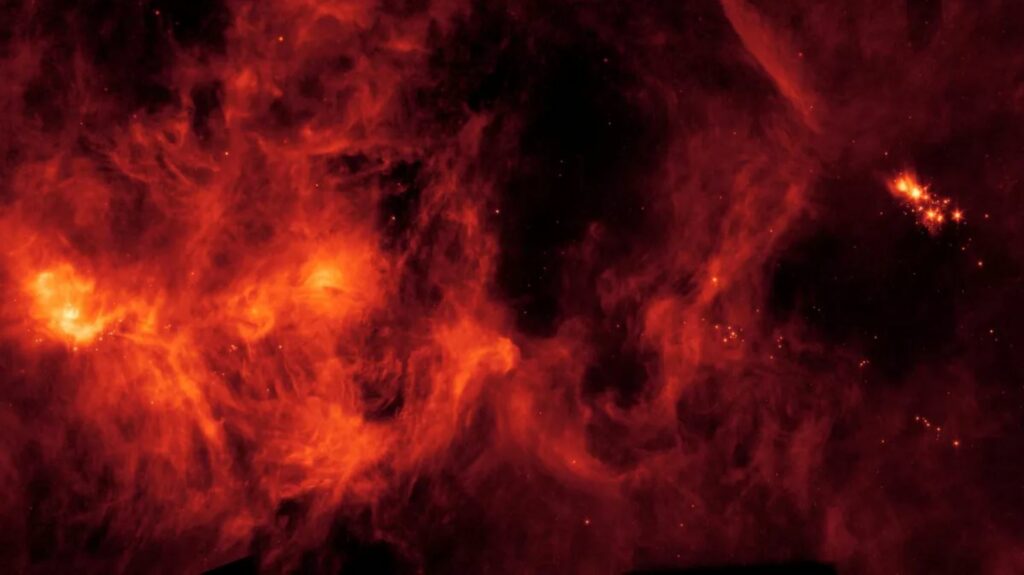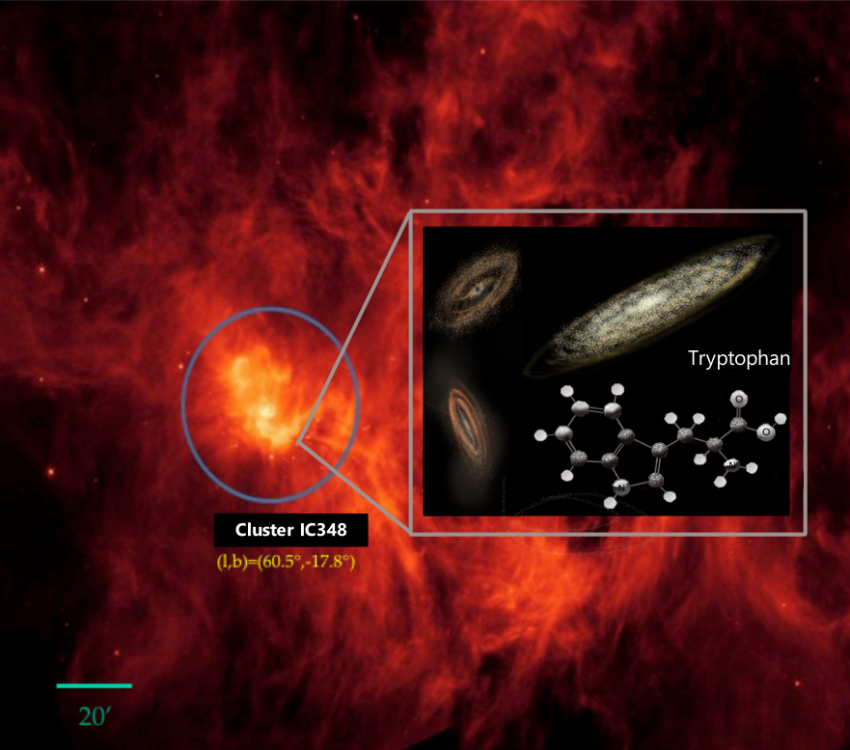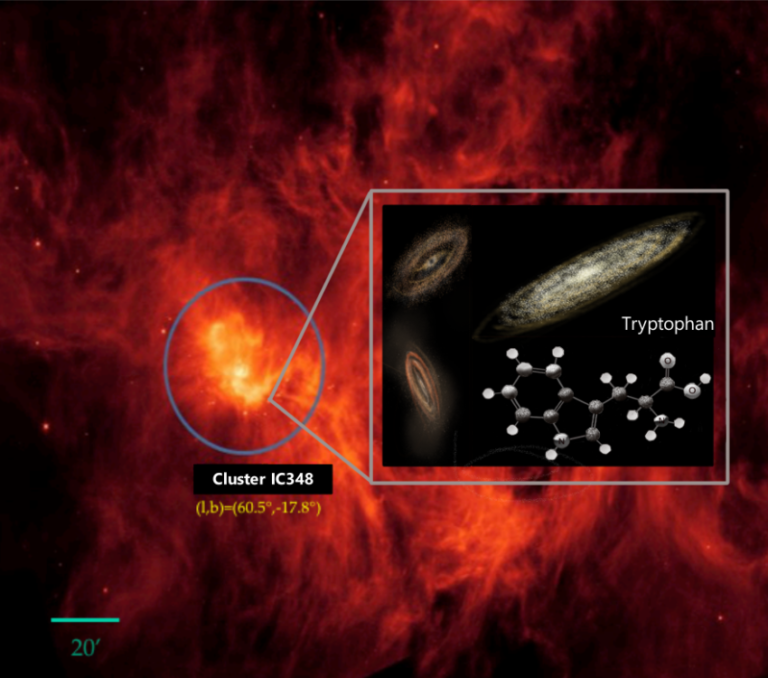Crucial Building Block for Life Discovered in Stellar Nursery 1,000 Light-Years Away from Earth
Tryptophan is one of 20 amino acids essential for forming key proteins needed for life.
Amino Acid Tryptophan Found in Abundance in Nearby Star-Birthing Region

In a remarkable astronomical revelation, astronomers have detected significant quantities of the amino acid tryptophan within interstellar material spanning a neighboring star-forming region in space. Tryptophan is one of the fundamental amino acids responsible for the formation of crucial proteins essential for sustaining life on Earth.
The unique spectral signatures of this amino acid were identified in data collected by the Spitzer Space Telescope, which captured infrared light emanating from the star-forming IC348 star system. This groundbreaking discovery suggests that amino acids, often present in meteorites, can also exist within the gas and dust particles that coalesce to give rise to planetary systems around young stars.
“The presence of tryptophan in the Perseus molecular complex should encourage further investigations into identifying other amino acids within this region and other star-forming areas,” stated Susana Iglesias-Groth, a researcher from the Instituto de Astrofísica de Canarias (IAC). “The possibility that protein-building blocks are widespread in the gaseous environments where stars and planets form is immensely exciting—it could be a key factor in the development of life in exoplanetary systems.”
IC348, an Integral Part of the Vast Perseus Molecular Complex
IC348 resides within the expansive Perseus Molecular Complex, an immense cloud composed of gas and dust, boasting a mass equivalent to that of 10,000 suns. This cosmic congregation, estimated to be relatively youthful compared to our 4.5 billion-year-old solar system, is believed to be a mere 2-3 million years old in the grand timeline of the universe.
Situated at a distance of approximately 1,000 light-years from Earth, IC348 stands as one of the closest star-forming regions to our planet. Although typically invisible to the naked eye, this region emits a vibrant glow in the infrared spectrum. In the course of scrutinizing these infrared emissions, researcher Iglesias-Groth made a groundbreaking discovery—an astounding 20 emission lines of the amino acid tryptophan.
This form of light analysis, known as spectroscopy, unravels the chemical composition of molecular clouds, interstellar gases, stars, and planetary atmospheres. Different chemical elements and compounds possess distinct light absorption and emission patterns at characteristic wavelengths, imprinting their “fingerprints” on the traversing light—an invaluable resource that space telescopes can unveil.
Interestingly, the identified tryptophan molecules within IC348 exhibit a temperature of approximately 44 degrees Fahrenheit (around 7 degrees Celsius).

IC348 has the right “soup” for life
Iglesias-Groth, utilizing spectrography alongside the Spitzer telescope, previously detected vital biological precursors to life within the star system IC348. Notably, in 2019, she unveiled the presence of complex carbon molecules, specifically carbon-60 or “fullerenes,” which serve as fundamental constituents for key life-building molecules within the region.
Continuing her exploration, earlier this year, Iglesias-Groth made another significant breakthrough, unveiling a diverse “soup” of complex molecules within the star cluster. This molecular concoction included molecular hydrogen (H2), hydroxyl (OH), water (H2O), carbon dioxide (CO2), and ammonia (NH3). Additionally, several carbon-based molecules with the potential to contribute to the formation of more intricate hydrocarbons and prebiotic molecules were discovered, such as hydrogen cyanide (HCN), ethane (C2H6), hexatrine (C6H2), and benzene (C6H6).
Iglesias-Groth emphasized the remarkable richness and diversity of molecular content within IC348. “The novelty lies in observing these molecules within the diffuse gas, which serves as the birthplace of stars and protoplanetary discs,” she stated in an earlier release.
The significance of these prebiotic molecules within the gas and dust clouds lies in the possibility that young planets, during their formation, can accrete these molecules onto their surfaces, potentially fostering the development of life. Alternatively, these molecules may become encapsulated within asteroids, remnants of planetary birth, and subsequently be delivered to the surfaces of other planets through impactful interactions during the tumultuous early stages of planetary systems.
Irrespective of the delivery mechanism, once present on planetary surfaces, these molecules can engage in chemical processes that culminate in the formation of proteins, eventually paving the way for the emergence of life.
Building upon their previous research conducted with the Spitzer telescope, Iglesias-Groth plans to further investigate the subject using the advanced capabilities of the James Webb Space Telescope (JWST).
“The spectroscopic capabilities offered by the JWST present an opportunity to delve deeper into the spatial distribution of these molecules and expand our exploration to more intricate compounds. This enhanced sensitivity and resolution are vital for confirming the highly probable presence of amino acids within the gas of not only this star-forming region but also in other similar regions,” expressed Iglesias-Groth earlier this year.
The research led by Iglesias-Groth is published in the journal Monthly Notices of the Royal Astronomical Society.
Do not forget to share your opinion with us to provide you with the best posts !




0 Comments